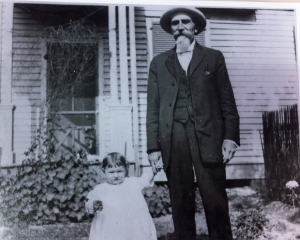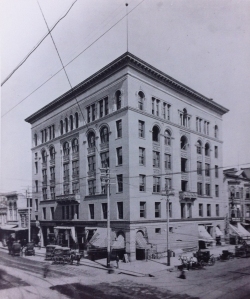Alethea Drexler
archives assistant
Let the Centennial celebration begin!
We have a new display in the Library lobby of photographs of Houston in the early twentieth century. Most of them are not directly related to medicine; there are a few of George Hermann and of some of the early hospitals, but the rest are simply street scenes, other buildings, and people. Daily life in Houston a hundred years ago. Since some of our readers don’t live nearby and won’t be stopping in to see them in person, I’ll share them here, with extended captions.
George Hermann (1843-1914)[1] with little May Ewing[2], daughter of Hermann Estate trustee T.J. Ewing, circa 1913. Hermann lived with the Ewing family the last years of his life. Ewing and the other trustees would later be accused of misusing the Estate’s funds[3].
 George Hermann’s funeral, 1914[4]: This picture, taken on Texas Avenue at Main Street, shows the crowds that came out to see the hearse on its way to Glenwood Cemetery. Just visible behind the hearse is the rump of Hermann’s favorite horse, Leo[5], with boots reversed in the stirrups and part of a sign that appears to read “MY MASTER”.
George Hermann’s funeral, 1914[4]: This picture, taken on Texas Avenue at Main Street, shows the crowds that came out to see the hearse on its way to Glenwood Cemetery. Just visible behind the hearse is the rump of Hermann’s favorite horse, Leo[5], with boots reversed in the stirrups and part of a sign that appears to read “MY MASTER”.
The mix of transportation here is interesting: Cars, horse-drawn buggies and wagons, a bicycle, and a streetcar. The horses pulling the old-fashioned carved hearse are wearing knotted-string fly nets. The building in the background, its exterior covered in advertising, is the “New Dreamland Theater”.
 Hermann Park dedication, 1914[6]: Hermann gave the city of Houston 285 acres for the creation of a park, in May 1914[7].
Hermann Park dedication, 1914[6]: Hermann gave the city of Houston 285 acres for the creation of a park, in May 1914[7].
 The Baker Estate[8] with Hermann Hospital and Hermann Park in the background, circa 1925. This photograph is at least ten years later than the rest of our display, but we included it to show how forested and undeveloped this part of the city still was. Hermann Hospital is the large, light-colored, building in the upper left.
The Baker Estate[8] with Hermann Hospital and Hermann Park in the background, circa 1925. This photograph is at least ten years later than the rest of our display, but we included it to show how forested and undeveloped this part of the city still was. Hermann Hospital is the large, light-colored, building in the upper left.
The James Baker estate would later become the first home of M.D. Anderson Cancer Center[9].
 First Evangelical Lutheran Church, circa 1910[10]: Since everyone got so involved in identifying it, we included the church from our September 30 and October 1 blog posts.
First Evangelical Lutheran Church, circa 1910[10]: Since everyone got so involved in identifying it, we included the church from our September 30 and October 1 blog posts.
 Blair Sanitarium, circa 1915[11]: Also making a repeat appearance is John M. Blair, M.D.’s private hospital, which appeared in its own post on June 3, 2011.
Blair Sanitarium, circa 1915[11]: Also making a repeat appearance is John M. Blair, M.D.’s private hospital, which appeared in its own post on June 3, 2011.
Blair was the president of the Houston Academy of Medicine in 1915 and served at some point as the editor of the journal Southwestern Medicine.
This would now be 1212 Rothwell, midway between White Oak Bayou and the St. Arnold’s Brewery. The building in the distance with the arch over the doorway is 1302 Nance Street (at Richey Street) and houses the restaurant Oxheart.
 A screen capture from Google Maps[12] shows us what this block looks like now:
A screen capture from Google Maps[12] shows us what this block looks like now:
 The building on the right appears to be what remains of the Brooklyn Hotel[13] (one of several names under which it operated over the years).
The building on the right appears to be what remains of the Brooklyn Hotel[13] (one of several names under which it operated over the years).
Great Atlantic and Pacific Tea Company [14] circa 1905. Gilman & Company was founded in New York in the 1850’s and began importing and distributing tea and coffee in 1859. It changed its name to the Great Atlantic and Pacific Tea Company in honor of the 1869 completion of the Transcontinental Railway. It began selling a wider variety of food items in the 1880’s, making it the nation’s first grocery-store chain. Acting as both wholesaler and retailer, it was known for low prices, and by 1915, the company operated 1,600 stores nationwide, plus a mail-order branch. It survives today as A&P[15].
This beautiful Renaissance Revival building was located at 517 Main[17]; the name of the Tea Company can just barely be seen above the entrance. The photo was probably taken just after the turn of the 20th century. Most of the vehicles on the street are horse-drawn wagons and coaches, but there is an automobile of extremely early design at the right.
The Binz Building was erected in 1895 and demolished in 1950. George Hermann kept businesses offices there for awhile before the Stewart Building was built in 1906.
 Here is that block today. Sigh. [18]
Here is that block today. Sigh. [18]
Sources consulted:
[1] Handbook of Texas Online: George Henry Hermann.
[2] McGovern Research Center Hermann History photo collection, folder 8.
[3] Texas Monthly magazine, February 1986, page 175.
[4] McGovern Research Center photo collection.
[5] Examiner.com, July 23, 2011, Marie Brannon, “The Funeral of George H. Hermann“.
[6] McGovern Research Center Hermann History photo collection, folder 16.
[7] Hermann Park Conservancy, History.
[8] McGovern Research Center P-3312 (oversized).
[9] M.D. Anderson online, “Who was MD Anderson?“.
[10] McGovern Research Center Hermann History photo collection, folder 25.
[11] McGovern Research Center photo collection, Buildings, “B”.
[12] Google Maps
[13] Examiner.com, Marie Brannon, September 16, 2011, “A Fifth Ward Hotel That Wouldn’t Die“.
[14] McGovern Research Center Hermann History photo collection, folder 24.
[15] Wikipedia: The Great Atlantic and Pacific Tea Company.
[16] The Great Atlantic and Pacific Tea Company online, Our History.
[17] Galveston Daily News, Wednesday, August 2, 1905, page 7. On Newspapers.com.
[18] Google maps.


Leave a comment